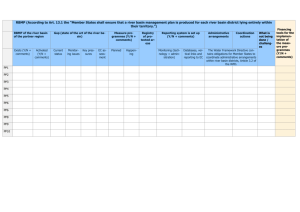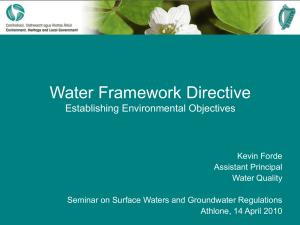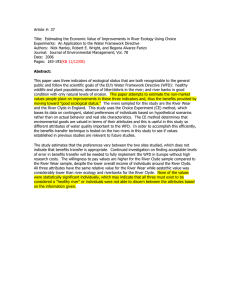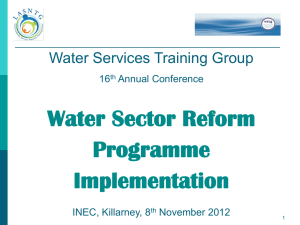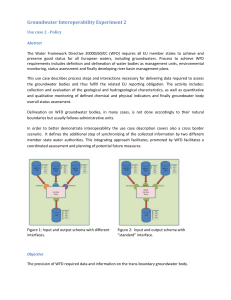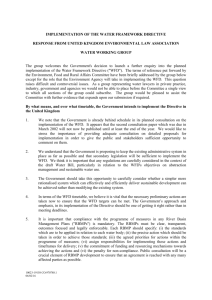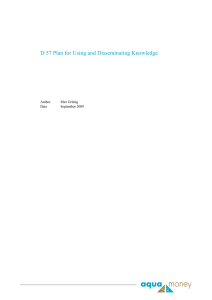Final Activity Report AQUAMONEY, Contract no. SSPI-022723 Author Date
advertisement
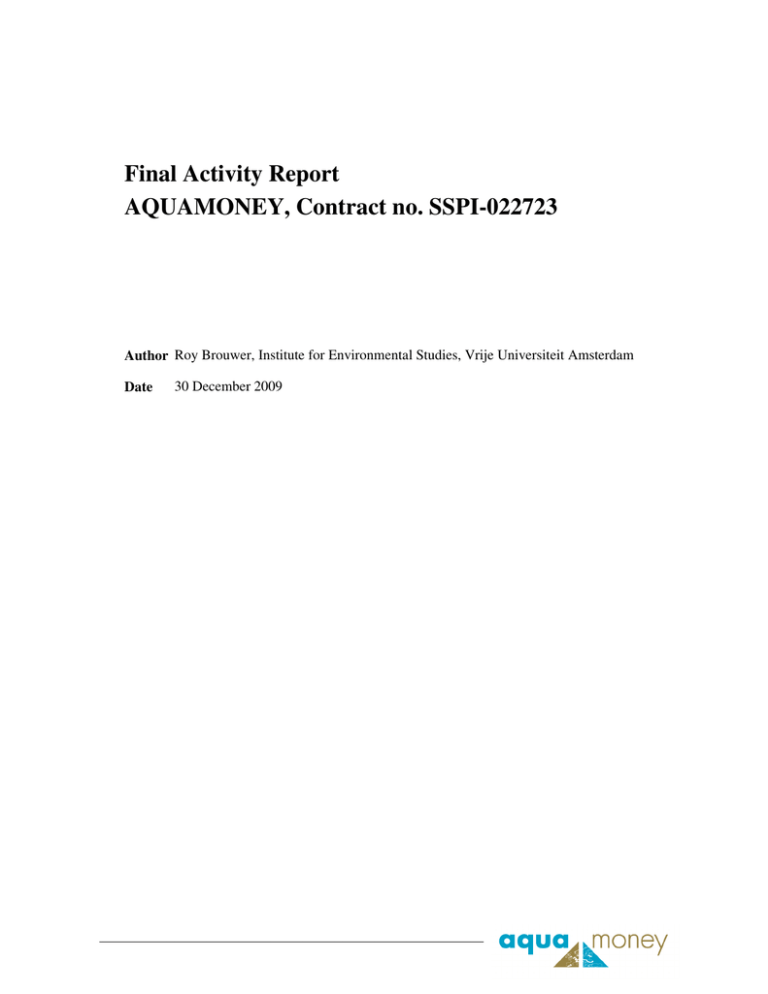
Final Activity Report AQUAMONEY, Contract no. SSPI-022723 Author Roy Brouwer, Institute for Environmental Studies, Vrije Universiteit Amsterdam Date 30 December 2009 Contact information AQUAMONEY partners Colophon This report is part of the EU funded project AQUAMONEY, Development and Testing of Practical Guidelines for the Assessment of Environmental and Resource Costs and Benefits in the WFD, Contract no SSPI-022723. General Deliverable D4 AQUAMONEY Final Activity Report Complete reference Brouwer, R. (2009). AQUAMONEY Final Activity Report. IVM, Vrije Universiteit Amsterdam. Status Author(s) Date Approved / Released Roy Brouwer 30 December 2009 Confidentiality Public X Restricted to other programme participants (including the Commission Service) Restricted to a group specified by the consortium (including the Advisory Board) Confidential, only for members of the consortium Accessibility Workspace X Internet X Paper X Executive Summary The economic valuation of the environmental and resource costs associated with water services and the benefits associated with sustainable water use and good water status is an essential element of the European Water Framework Directive (WFD). Environmental and resource costs are an explicit feature of Article 9 of the Directive and are expected to also play an important role in the identification of disproportionate costs (Article 4) and the selection of programmes of measures to achieve the environmental objectives (Article 11). However, despite their important role, there exist no methodological guidelines regarding their practical assessment and inclusion within economic analyses of the WFD. Typically, the necessary investment costs in water management are relatively well-known, but not the socio-economic values generated by water quality improvements. In order to fill this gap in knowledge, the Specific Targeted Research Project AQUAMONEY was funded by DG Research from the 1st of April 2006 until the 30th of September 2009. AQUAMONEY consists of 16 international consortium partners from 13 different EU Member States and Norway, of which 9 are universities: - VU University Amsterdam (NL) - University of East Anglia (UK) - Politechnical University of Valencia (SP) - University of Life Sciences (NO) - University of Bologna (IT) - University of Bucharest (RO) - Corvinus University Budapest (HU) - University of the Aegean (GR) - University of Copenhagen (DK) and 7 are policy research institutes: - Ecologic Institute for International and European Environmental Policy (DE) - Research Institute for Soil Science and Agricultural Chemistry (HU) - Center for Environmental Policy (LT) - Flemish Institute for Technological Research (BE) - Bureau de Recherches Géologiques et Minières (FR) - Norwegian Institute for Water Research (NO) - Institute for Advanced Studies Carinthia (AT). In the project 9 known environmental economics professors specialized in water economics and economic valuation of environmental change participated, including Prof. Ian Bateman (UEA), Prof. Ståle Navrud (UMB), Prof. Michalis Skourtos (University of the Aegean), Prof. Joaquin Andreu (UPV), Prof. Alex Dubgaard (University of Copenhagen), Prof. Sandor Kerekes (CUB), Prof. Michael Getzner (University of Klagenfurt) and Prof. Angheluta Vadineanu (University of Bucharest). AQUAMONEY was coordinated by Prof. Roy Brouwer from the Department of Environmental Economics, Institute for Environmental Studies, VU University Amsterdam. The project website is found at www.aquamoney.org. The project AQUAMONEY aims to develop guidelines for the economic valuation of environmental and resource costs and benefits related to water use and water services to be included in the economic analysis in the WFD. The guidelines focus on key methodological issues in water resource valuation, including the use and transferability of existing economic values, in the specific context of the WFD. The guidelines provide particularly more guidance on the assessment of the non-market welfare implications of WFD implementation, including an extensive list of water ecosystem goods and services and associated socio-economic benefits provided by the WFD. 1 The guidelines discuss the definition of environmental and resource costs in the context of article 9 in the WFD and the concept of cost recovery. Environmental and resource costs are not defined in the WFD. The guidelines aim to clarify the economic meaning of the terms in article 9. Cost recovery is a well-known economic pricing principle referring to the recovery of the total economic costs of a good or service. Economic valuation of the environmental and resource costs related to the goods and services provided by the WFD includes more than a financial analysis of the costs of water service provision as defined in paragraph 38 in Article 2. Related to the ‘no deterioration’ rule in the WFD in paragraph 4.4 in Article 4 - meaning that water status is not allowed to deteriorate only to improve from the current baseline conditions - the environmental and resource costs are equal to the benefits foregone of not reaching the WFD objectives. In order to achieve the project’s main objective, a three-year work plan was developed. The work in the project was organized in 6 Work Packages (WPs): - WP-0: overall project coordination and management - WP-1: inventory of policymaker demand for guidelines - WP-2: meta-analysis of existing economic valuation studies - WP-3: development of guidelines - WP-4: testing of guidelines in practical case studies - WP-5: communication and dissemination The links and internal coherence between the different WPs is visualized in Figure 1 (excluding WP0 for overall project coordination). Figure 1: Visualization of the links between AQUAMONEY Work Packages Based on the inventory of policymaker demand for guidelines on water resource valuation in the WFD in WP1, the meta-analysis of existing economic water resource valuation studies and the subsequent inventory of key methodological issues in WP2, draft guidelines for economic water resource valuation in the specific context of the WFD were developed in WP3 and tested in WP4. Also the WP4 case studies were set-up following local policymaker demand for information about the economic values associated with WFD implementation. The guidelines were further refined based on the results from the case studies. The guidelines and case study results were synthesized disseminated through AQUAMONEY policy briefs. 2 In the first year draft guidelines were developed. The guideline development process in the first project year was informed by (i) an inventory and critical review of existing guidelines and key issues in water resource valuation, (ii) an inventory of policymaker demand for guidance on economic valuation issues in the WFD. The draft guidelines were subsequently tested in the second and third year in 13 different EU Member States in practical case studies organized around the three main WFD related water management issues across north, south, east and west Europe: 1) Improvement of water quality to good chemical and ecological status: a) Humber catchment (UK) b) International Scheldt river basin (NL, BE) c) Morsa catchment (NO) d) Neris river basin (LT) e) Odense river basin (DK) f) Upper Rhine river basin (FR) g) Guadalquivir river basin (SP). 2) Ecological restoration of heavily modified water bodies (HMWB) in the international Danube river basin (AT, HU, RO). 3) Water allocation and conservation under climate change and increasing water scarcity conditions: a) Serpis river basin (SP) b) Guadalquivir river basin (SP) c) Po river basin (IT) d) Lesvos catchment (GR). Two case studies addressed water management issues in an international river basin context: the Danube (AT, HU, RO) and the Scheldt (NL, BE). Moreover, the Humber is the largest catchment in the UK and the Danube the second largest river basin is in Europe and heavily modified in the past centuries and decades for hydropower and navigation. The Scheldt and Odense river basins were pilot river basins under the WFD Common Implementation Strategy (CIS) at the time of the project start. The case study results were incorporated in the draft guidelines in the third year. The translation of context-specific water management conditions into a common research design with the help of water experts and stakeholders (hydrologists, ecologists, water managers, sector representatives from agriculture and nature conservation) to accommodate and facilitate cross-country comparisons was a time-consuming activity, required extra input and resulted in a six months extension of the project granted by the EC. Much time and effort in the practical testing of the guidelines went into the development of common, practically applicable water quality and environmental flow ladders across EU member states together with water scientists, translating the WFD objectives into goods and services and explaining what good water status means for different groups of water users and nonusers. The case study results were analyzed and incorporated into the final version of the guidelines in the first 6 months of the fourth year. This process is visualized in Figure 2. 3 Figure 2: Visualization of the links between the technical and process oriented pathways in AQUAMONEY Note: HMWB are heavily modified water bodies The entire project consortium met 6 times throughout the project lifetime: in the first month at the kickoff meeting in Amsterdam, at the end of the first year in Berlin, after a year and a half in Bologna, after 2 years in Budapest, after two and a half year in Valencia and at the beginning of the fourth project year at the final project meeting in Amsterdam. In order to streamline all the case studies, two additional (originally unplanned) project meetings were organized for the international Danube case study (in Budapest) and the water quality case studies (in Amsterdam) and an originally unplanned four day internal capacity building course at the VU University in Amsterdam with 20 project participants and external tutors (including Prof. Nick Hanley - University of Stirling and Prof. Anna Alberini - University of Maryland) for the analysis of the collected data in the case studies. The development of a common research design for all case studies is unique as this has never been developed for European water bodies before. Also the integration of the relevant WFD management issues into a coherent and consistent way in the three main clusters of case studies and the intensive collaboration in AQUAMONEY between all 16 international partners is considered a unique achievement. Throughout the project life-time, activities and intermediate results were presented to local policymakers and stakeholders involved in the individual case studies for feedback and the 18 members of the project Advisory Board to ensure proper policy embedding of the technical project outcomes. These policymakers and other stakeholders also played an important role in the beginning of the project as they were consulted about policymaker and stakeholder demand for guideline development. The AQUAMONEY Advisory Board met 3 times over the project lifetime and includes representatives from the European Commission DG-Research and DG-Environment, the European Federation of National Associations of Drinking water Suppliers and Waste Water Services (EUREAU), members of different EU CIS working groups, the Secretary-General of the International Scheldt Commission, the European, and representatives from national Environment 4 and Water Ministries (UK, NL, HU, SP, GR, IT) and Water and Environment Agencies (DE, BE, FR, NO, DK, SE). The most important project outputs are (1) the technical guidelines on water resource valuation in the context of the WFD targeting practitioners, and (2) a series of policy briefs informing policymakers and other stakeholders about the use and usefulness of the AQUAMONEY project outcomes (available from www.aquamoney.org). Plans exist to publish the technical guidelines as a book. The final project results were presented at the Water Economics Preconference to the Annual Conference of the European Association of Environmental and Resource Economists 24-27 June 2009 in Amsterdam1. This Preconference was organized back-to-back to the final plenary AQUAMONEY project meeting in Amsterdam and attracted around 200 international participants, including members of the AQUAMONEY Advisory Board. At the Preconference the AQUAMONEY partners presented an overview of the AQUAMONEY guidelines and the AQUAMONEY case study results. Besides the organization of a successful major scientific event, the number of scientific peer reviewed journal articles is another important indicator of the scientific quality of the work carried out in AQUAMONEY. At the time of the writing of this final report, a number of peer reviewed scientific journal articles were already published, in press or under review: • • • • • • • Bateman, I.J, Brouwer, R. et al. (2006). Analyzing the agricultural costs and non-market benefits of implementing the Water Framework Directive. Journal of Agricultural Economics, 57(2), 221-237. Brouwer, R. (2008). The role of stated preference methods in the Water Framework Directive to assess disproportionate costs. Journal of Environmental Planning and Management, 51(5), 597-614. Brouwer, R. (2010). A mixed approach to payment certainty calibration in discrete choice welfare estimation. Applied Economics, in press (DOI 10.1080/00036840903035977). Brouwer, R., Martín-Ortega, J. and Berbel, J. (2010). Spatial preference heterogeneity: a choice experiment. Land Economics, in press. Brouwer, R., Dekker, T., Rolfe, J. and Windle, J. (2010). Choice certainty and consistency in repeated choice experiments. Environmental and Resource Economics, in press (DOI 10.1007/s10640-009-9337-x). Bateman, I.J., Brouwer, R., Ferrini, S., Schaafsma, M. et al. Making benefit transfers work: Deriving and testing principles for value transfers for similar and dissimilar sites using a case study of the non-market benefits of water quality improvements across Europe. Land Economics, under review. Bliem, M., Brouwer, R. et al. Ecosystem service valuation from floodplain restoration in the Danube River Basin: An international choice experiment. Ecological Economics, under review. Finally, although the project aimed to involve and engage policy and decision-makers in the project right from the start, the policy impact of AQUAMONEY still has to largely manifest itself after publication of the guidelines for practitioners. The project was referred to in the European Commission’s first report in 2007 on WFD implementation: Communication from the Commission to the European Parliament and the Council - Towards sustainable water management in the European Union - First stage in the implementation of the Water Framework Directive 2000/60/EC (SEC(2007) 362), and has been presented at different national and international policy events, including at European level: 1 See http://www.eaere2009.org/. Click Programme, then Preconference Water Economics. 5 - The 1st Expert workshop on Cost-Benefit Analysis and the Water Framework Directive organized by DG Environment in Brussels in November 2006. The 2nd meeting of the CIS Drafting Group on Environmental Objectives and Exemptions in Brussels in April 2007. The International Water and Sustainable Development Exhibition in Zaragoza from June to September 2008. The 5th International Water Technologies, Renewable Energy & Environmental Control Exhibition and the 2nd International Conference (WATEC 09) in Tel Aviv, Israel from 17 to 19 November 2009. Some other remarkable dissemination activities and results include that the AQUAMONEY case study results were used in Belgium for the disproportionality analysis for the Flemish government, while the project coordinator was invited in 2008 by the Australian Government under its National Research Flagship ‘Water for a Healthy Country’ to assist in the development of a sustainable water conservation policy strategy under climate change using the new knowledge developed in AQUAMONEY. The common research design developed in AQUAMONEY was applied in a case study in Queensland. This scientific collaboration resulted in a joint paper presented among others at the 53rd Annual Conference of the Australian Agricultural and Resource Economics Society in Cairns. The paper is forthcoming in the journal Environmental and Resource Economics. Project partners were involved in numerous presentations targeting policymakers at regional and national level, for instance during the international policy workshop ‘How can economics best support water policy decision making? Taking stocks of the first years of WFD implementation’ in Alsace in May 2007, the 4th Harmoni-CA policy workshop on ‘Using economic methods and models for the implementation of the Water Framework Directive’ in Berlin in June 2007, and the WFD policy seminar organized by the University of Bologna for the Po Basin Authority in September 2007. Further details of communication and dissemination activities are reported in the AQUAMONEY final dissemination of knowledge plan. 6
